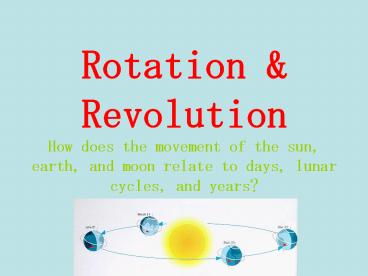Rotation PowerPoint PPT Presentation
1 / 45
Title: Rotation
1
Rotation RevolutionHow does the movement of
the sun, earth, and moon relate to days, lunar
cycles, and years?
2
Orbit the path the earth takes to travel around
the sun.
orbit
sun
3
- ROTATION
4
Rotation the Earth spinning on its axis.
earth
5
Period of Rotation The amount of time it takes
for this rotation to happen one day (24 hours)!
6
Rotation AAxis
7
- REVOLUTION
8
Revolution - the motion of the Earth orbiting
around the sun.
- sun
earth
9
Period of Revolution the amount of time it
takes for an object to orbit around the sun once
One year (365 Days).
earth
sun
10
Every planet revolves around the Sun! The closer
you get to the sun the shorter the
revolution/orbit.
Shorter years
Longer years
11
Rotation/Revolution Animation
- http//esminfo.prenhall.com/science/geoanimations/
animations/01_EarthSun_E2.html
12
Revolution
13
- Review QUESTIONS
14
What does each letter represent?
C
A
- earth
sun
sun
B
15
(No Transcript)
16
(No Transcript)
17
(No Transcript)
18
Rotation or Revolution?
19
Rotation or Revolution?
20
Rotation or Revolution?
21
- SOLAR Lunar ECLIPSE
Objective What is the difference between a solar
and a lunar eclipse?
22
Solar Eclipse Details
Moon
A solar eclipse occurs when the moon comes
between the Earth and the sun. MMS Moon Middle
Solar
23
(No Transcript)
24
(No Transcript)
25
Partial Solar Eclipse
- The moon passes between Earth and the Sun. The
moon covers part of the sun.
26
Total Solar Eclipse
- Moon passes directly between Earth and the Sun.
Moon blocks our view of the Sun. Only the Suns
corona is visible.
27
Annular Solar Eclipse
- Moon passes directly between Earth and the Sun.
The moon appears smaller than in a total eclipse
because it is further from the earth.
28
- LUNAR ECLIPSE
29
A Lunar Eclipse
During a Lunar Eclipse the Earths shadow falls
on the moon and the moon can look RED!!!
Moon
30
(No Transcript)
31
The moon becomes a blood red color during a total
lunar eclipse. No wonder that ancient cultures
feared the appearance of the moon during a lunar
eclipse.
32
(No Transcript)
33
Review Questions
34
(No Transcript)
35
(No Transcript)
36
Answer
37
What type of eclipse?
38
- Earths axis goes directly through _______.
- The north and south poles
- The sun
- The common center of mass
39
- When we watch the sun rise and set we are
actually experiencing Earths ____. - Rotation on its axis
- Revolution around the sun
- Revolution around the moon
40
- Fewer people can see total solar eclipses than
lunar eclipses because - A) the Moon casts a smaller shadow than Earth
does - B) solar eclipses almost never happen
- C) only people at the South Pole can see solar
eclipses
41
- When Earth is directly in between the Sun and
the Moon, people on Earth experience a
__________. - A) lunar eclipse
- B) solar eclipse
- C) half Moon
42
- When the Moon is directly in between the Sun and
Earth, some people on Earth may experience a
__________. - A) solstice
- B) lunar eclipse
- C) solar eclipse
43
- A lunar eclipse occurs when ___.
- A) the Sun passes into the Earths shadow
- B) the Earth passes into the Moons shadow C) the
Moon passes into Earths shadow - D) the Moon passes into the Suns shadow
44
- When a lunar eclipse occurs what happens to the
Moon? - A) It vanishes from existence, to be recalled on
the whim of a magician. - B) It is covered in shadow and hidden from view
for a brief time. - C) It becomes extraordinarily bright.
- D) Nothing happens to it.
45
- When a solar eclipse occurs, what happens to the
Moon? - A) It falls into the Earths shadow.
- B) It moves between the Earth and the Sun,
causing a part of the Earth to fall into its
shadow. - C) It lies outside of a straight line connecting
the Earth and Sun. - D) It disappears from view.

